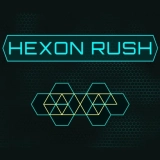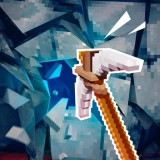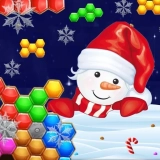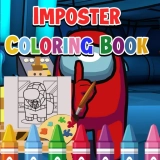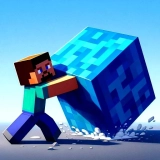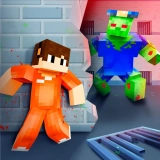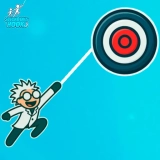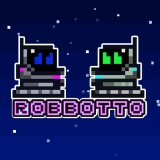Deadly Parkour
Played 51 times.
- % (0/0)
**Dynamic Duo** sounds like a fantastic and challenging game concept! Here's how we can build on this idea to create an engaging experience for players:
---
### **Game Title**: *Dynamic Duo*
**Tagline**: *Two Heroes, One Quest – Precision and Teamwork in Every Jump!*
---
### ??? **Gameplay Concept:**
**Dynamic Duo** is all about **two distinct characters** who complement each other with unique abilities. Players will have to switch between them to navigate through complex, **precision-based platforming** challenges. The game focuses on **teamwork**, **reflexes**, and **strategic thinking**, offering an exciting blend of solo and cooperative mechanics.
---
### **Core Mechanics**:
1. **Control Two Characters**:
* Players control **two characters** simultaneously (or switch between them depending on the setup).
* Each character has their own set of **abilities** and **strengths** that players need to use in tandem to solve platforming puzzles and overcome obstacles.
**Example Characters**:
* **Character 1**: Fast and agile, with a double-jump ability or wall jump.
* **Character 2**: Strong and durable, can break obstacles or create paths with their powers.
2. **Switching Between Characters**:
* **Single-player mode**: The player can **switch between characters** on the fly, using each character’s specific skills to solve puzzles and progress.
* **Multiplayer mode**: Players can team up, each controlling one of the two characters, and work together to reach the goal.
3. **Precision Platforming**:
* The levels are designed to test **reaction time** and **precision**. Players will need to time their jumps, dashes, and ability use to make it through tricky obstacles like moving platforms, spikes, and narrow paths.
* Levels are hand-crafted to include a mix of **vertical and horizontal platforming** challenges, requiring players to think quickly and carefully about their next move.
4. **Obstacles and Traps**:
* Each level has unique traps and obstacles (e.g., **spikes**, **moving platforms**, **rotating blades**, **gravity flips**) that require precise timing and the use of the right character at the right time.
* **Environmental interactions** (such as switches, levers, or platforms) may require one character to be in a specific position while the other solves a challenge.
5. **Level Design**:
* **70 levels**: Each one is **meticulously hand-crafted** to offer a new challenge that tests the player’s abilities.
* As the game progresses, the difficulty increases, introducing more complex mechanics, enemies, and puzzle elements.
---
### ? **Unique Features**:
1. **Character Synergy**:
* The strength of **Dynamic Duo** lies in how the characters complement each other. Players need to **combine their abilities**, sometimes having one character hold a platform while the other jumps across, or using one character to create a shield while the other attacks.
2. **Precision and Reflexes**:
* Every jump counts! The platforming mechanics demand **fast reflexes**, as players must make quick, well-timed jumps, dodges, and attacks.
3. **Dynamic Environment**:
* **Interactive levels**: Levels feature environmental puzzles where the two characters must work together to activate switches, destroy barriers, or trigger actions that affect other parts of the level.
4. **Skill Progression**:
* Players unlock new **skills and abilities** as they progress through levels, making the characters more versatile and offering more ways to approach obstacles. For example, one character may gain the ability to temporarily freeze enemies, while the other might gain the ability to create portals.
5. **Replayability**:
* **Time trials** or **speed runs** for each level. Players can revisit levels to improve their times and scores, or even compete on leaderboards.
* Hidden collectibles scattered across levels encourage players to explore every corner of the environment.
6. **Co-op Multiplayer**:
* A **local or online co-op mode** where two players control the characters and must coordinate to solve puzzles and reach the goal. This mode requires great teamwork and coordination, as both players need to utilize each character's strengths to succeed.
---
### ? **Challenges and Achievements**:
1. **Hardcore Challenges**:
* For hardcore players, some levels could have additional **hardcore modes** with limited lives, stricter time limits, or no checkpoints, giving players a greater sense of achievement upon completion.
2. **Achievements and Unlockables**:
* Players can unlock **special costumes**, **skins**, or **concept art** as they progress. Achievements can include things like completing levels without taking damage, finishing levels under a time limit, or finding all hidden collectibles in each stage.
---
### ? **Controls**:
* **Single-player**:
* **Keyboard/Mouse**: Use arrow keys or WASD to move, and switch between characters with a designated key (e.g., **Spacebar** or **Tab**).
* **Gamepad**: Left analog stick for movement, buttons to jump or use abilities, and trigger buttons to switch between characters.
* **Co-op**:
* **Local Co-op**: Each player controls one character using either keyboard or gamepad.
* **Online Co-op**: Play with friends online, each controlling one character, or use matchmaking to find partners.
---
### ? **Visuals & Art Style**:
* **Stylized Graphics**:
* The game can feature a **colorful, vibrant art style** with **whimsical backgrounds** and **detailed characters**. Think of a cartoony yet polished look that adds charm to the precision platforming action.
* **Fluid Animations**:
* The animations for jumps, dashes, attacks, and character abilities need to be smooth and visually satisfying, especially when switching between characters or completing combo actions.
* **Dynamic Environments**:
* The levels could change depending on the abilities the characters have unlocked, offering new **visual experiences** as the player progresses.
---
### **Level Structure**:
* **Multiple Worlds**:
* Levels are organized into different **worlds**, each with a unique theme (e.g., Forest World, Lava World, Sky World) and its own set of challenges.
* **Boss Battles**:
* At the end of each world, there could be a **boss fight** where both characters’ abilities must be used in combination to defeat a powerful enemy.
---
### ? **Replayability & Future Expansions**:
* **Level Editor**: Allow players to create and share their own levels, adding new challenges and puzzles that can be played by others.
* **Seasonal Events**: Introduce **seasonal events** with exclusive levels, challenges, and rewards to keep the community engaged.
---
### **Conclusion**:
**Dynamic Duo** offers a perfect mix of precision platforming and teamwork, providing players with an exciting and challenging experience. Whether playing solo and switching between characters or teaming up with a friend in co-op mode, the game is built to test your reflexes, coordination, and puzzle-solving skills.
Would you like any help designing specific levels or implementing character abilities in Unity or another engine?
---
### **Game Title**: *Dynamic Duo*
**Tagline**: *Two Heroes, One Quest – Precision and Teamwork in Every Jump!*
---
### ??? **Gameplay Concept:**
**Dynamic Duo** is all about **two distinct characters** who complement each other with unique abilities. Players will have to switch between them to navigate through complex, **precision-based platforming** challenges. The game focuses on **teamwork**, **reflexes**, and **strategic thinking**, offering an exciting blend of solo and cooperative mechanics.
---
### **Core Mechanics**:
1. **Control Two Characters**:
* Players control **two characters** simultaneously (or switch between them depending on the setup).
* Each character has their own set of **abilities** and **strengths** that players need to use in tandem to solve platforming puzzles and overcome obstacles.
**Example Characters**:
* **Character 1**: Fast and agile, with a double-jump ability or wall jump.
* **Character 2**: Strong and durable, can break obstacles or create paths with their powers.
2. **Switching Between Characters**:
* **Single-player mode**: The player can **switch between characters** on the fly, using each character’s specific skills to solve puzzles and progress.
* **Multiplayer mode**: Players can team up, each controlling one of the two characters, and work together to reach the goal.
3. **Precision Platforming**:
* The levels are designed to test **reaction time** and **precision**. Players will need to time their jumps, dashes, and ability use to make it through tricky obstacles like moving platforms, spikes, and narrow paths.
* Levels are hand-crafted to include a mix of **vertical and horizontal platforming** challenges, requiring players to think quickly and carefully about their next move.
4. **Obstacles and Traps**:
* Each level has unique traps and obstacles (e.g., **spikes**, **moving platforms**, **rotating blades**, **gravity flips**) that require precise timing and the use of the right character at the right time.
* **Environmental interactions** (such as switches, levers, or platforms) may require one character to be in a specific position while the other solves a challenge.
5. **Level Design**:
* **70 levels**: Each one is **meticulously hand-crafted** to offer a new challenge that tests the player’s abilities.
* As the game progresses, the difficulty increases, introducing more complex mechanics, enemies, and puzzle elements.
---
### ? **Unique Features**:
1. **Character Synergy**:
* The strength of **Dynamic Duo** lies in how the characters complement each other. Players need to **combine their abilities**, sometimes having one character hold a platform while the other jumps across, or using one character to create a shield while the other attacks.
2. **Precision and Reflexes**:
* Every jump counts! The platforming mechanics demand **fast reflexes**, as players must make quick, well-timed jumps, dodges, and attacks.
3. **Dynamic Environment**:
* **Interactive levels**: Levels feature environmental puzzles where the two characters must work together to activate switches, destroy barriers, or trigger actions that affect other parts of the level.
4. **Skill Progression**:
* Players unlock new **skills and abilities** as they progress through levels, making the characters more versatile and offering more ways to approach obstacles. For example, one character may gain the ability to temporarily freeze enemies, while the other might gain the ability to create portals.
5. **Replayability**:
* **Time trials** or **speed runs** for each level. Players can revisit levels to improve their times and scores, or even compete on leaderboards.
* Hidden collectibles scattered across levels encourage players to explore every corner of the environment.
6. **Co-op Multiplayer**:
* A **local or online co-op mode** where two players control the characters and must coordinate to solve puzzles and reach the goal. This mode requires great teamwork and coordination, as both players need to utilize each character's strengths to succeed.
---
### ? **Challenges and Achievements**:
1. **Hardcore Challenges**:
* For hardcore players, some levels could have additional **hardcore modes** with limited lives, stricter time limits, or no checkpoints, giving players a greater sense of achievement upon completion.
2. **Achievements and Unlockables**:
* Players can unlock **special costumes**, **skins**, or **concept art** as they progress. Achievements can include things like completing levels without taking damage, finishing levels under a time limit, or finding all hidden collectibles in each stage.
---
### ? **Controls**:
* **Single-player**:
* **Keyboard/Mouse**: Use arrow keys or WASD to move, and switch between characters with a designated key (e.g., **Spacebar** or **Tab**).
* **Gamepad**: Left analog stick for movement, buttons to jump or use abilities, and trigger buttons to switch between characters.
* **Co-op**:
* **Local Co-op**: Each player controls one character using either keyboard or gamepad.
* **Online Co-op**: Play with friends online, each controlling one character, or use matchmaking to find partners.
---
### ? **Visuals & Art Style**:
* **Stylized Graphics**:
* The game can feature a **colorful, vibrant art style** with **whimsical backgrounds** and **detailed characters**. Think of a cartoony yet polished look that adds charm to the precision platforming action.
* **Fluid Animations**:
* The animations for jumps, dashes, attacks, and character abilities need to be smooth and visually satisfying, especially when switching between characters or completing combo actions.
* **Dynamic Environments**:
* The levels could change depending on the abilities the characters have unlocked, offering new **visual experiences** as the player progresses.
---
### **Level Structure**:
* **Multiple Worlds**:
* Levels are organized into different **worlds**, each with a unique theme (e.g., Forest World, Lava World, Sky World) and its own set of challenges.
* **Boss Battles**:
* At the end of each world, there could be a **boss fight** where both characters’ abilities must be used in combination to defeat a powerful enemy.
---
### ? **Replayability & Future Expansions**:
* **Level Editor**: Allow players to create and share their own levels, adding new challenges and puzzles that can be played by others.
* **Seasonal Events**: Introduce **seasonal events** with exclusive levels, challenges, and rewards to keep the community engaged.
---
### **Conclusion**:
**Dynamic Duo** offers a perfect mix of precision platforming and teamwork, providing players with an exciting and challenging experience. Whether playing solo and switching between characters or teaming up with a friend in co-op mode, the game is built to test your reflexes, coordination, and puzzle-solving skills.
Would you like any help designing specific levels or implementing character abilities in Unity or another engine?
Instructions:
Great! It sounds like you have a well-defined control scheme for your game, **Dynamic Duo**. Here’s how to incorporate the controls, as well as additional gameplay mechanics, to make it smooth and engaging:
---
### **Gameplay Controls** for **Dynamic Duo**:
* **Movement**:
* **Arrow Keys** or **WASD Keys**: Use these to move both characters around the level. You’ll need to switch between the characters or control them simultaneously, depending on the game mode.
* **Special Ability**:
* **Spacebar** / **X** / **J**: Each character has a **special ability** activated by pressing one of these keys. For instance:
* **Character 1** might have a **double-jump** or a **dash** ability.
* **Character 2** might have the ability to **break obstacles** or **create platforms**.
* **Objective**:
* Your goal in each level is to **reach the portal** to complete the stage. To do this, you’ll need to use both characters' abilities to navigate the platforming challenges and clear any obstacles blocking your path.
---
### **Core Mechanics and Examples**:
1. **Character Switching**:
If you are using **two characters** that need to be controlled separately or switched between:
* **Single-player**: Use the **Tab key** or another button (like **1/2**) to switch between the characters.
* **Co-op multiplayer**: Each player controls one character, so you won’t need to switch but will need to work together to solve platforming puzzles.
2. **Special Abilities Usage**:
* Each character’s special ability can be used strategically to overcome obstacles. For example:
* **Character 1** (e.g., the faster, more agile character) could use **double-jump** to clear gaps, while **Character 2** (stronger or more durable) could use **smash** abilities to break through walls.
* **Character 1's Ability** (e.g., a dash): Use the **Spacebar** or **X** to dash through gaps or to break through barriers.
* **Character 2's Ability** (e.g., shield): Use **J** to create a temporary shield that blocks enemy attacks or allows you to pass through hazardous areas.
3. **Level Objectives**:
* Each level will have obstacles that require **teamwork** between the characters or precision control to overcome.
* Some platforms may only appear for a short time or require the use of **special abilities** to unlock or create paths.
4. **Co-op Mode**:
* **Multiplayer**: Player 1 controls **Character 1**, and Player 2 controls **Character 2**.
* Players will need to coordinate their actions to reach the portal, with each character’s unique abilities complementing the other’s.
---
### **Level Design Tips**:
* **Puzzle Areas**: Design levels where both characters’ special abilities are required to solve puzzles. For instance:
* **Character 1** might need to jump over an obstacle while **Character 2** creates a temporary bridge for them to walk across.
* **Precision Platforming**: Create sections where players must be extremely precise with their jumps and timing, rewarding players who can master the control mechanics.
* **Hazard Zones**: Add sections with **spikes**, **moving platforms**, or **enemies** where the player needs to use abilities to avoid damage and progress.
* **Portals**: The ultimate goal of each level is to reach the **portal**, which could be activated by completing puzzles, defeating bosses, or simply reaching a specific location. Players will feel a sense of achievement when they finally reach the portal after overcoming the level’s challenges.
---
### **Example of Level Flow**:
1. **Starting the Level**:
* Players begin at the starting position, with an introductory challenge where **Character 1** must **jump** across platforms while **Character 2** uses their ability to **smash a wall** that’s blocking the path.
2. **Mid-Level Challenge**:
* The player encounters a series of **moving platforms** and **spike traps**. They must use **Character 1’s** agility to jump and **Character 2’s** ability to create temporary platforms to navigate the section.
3. **Final Stretch**:
* As the portal gets closer, the player must **time jumps precisely** using both characters to leap over a **gap** while avoiding **falling obstacles**. Both characters' abilities are required to finally reach the portal.
4. **Reaching the Portal**:
* Once both characters reach the **portal**, the level is completed. If the level is a **co-op mode**, both players must enter the portal at the same time, or one player may have to help the other.
---
### **Game Flow**:
* **Difficulty Progression**: Start with simple levels that teach players how to switch between characters and use their abilities, then gradually increase the difficulty by introducing more complex platforming, obstacles, and traps.
* **Unlockables**: Players can unlock additional **skins**, **abilities**, and **level themes** as they progress.
---
### **Visual and Sound Design**:
* **Visuals**: Keep the art style **colorful and engaging**. Design vibrant backgrounds, with each level having its own unique aesthetic (e.g., forest, lava, ice, etc.).
* **Sound Design**: Use **satisfying sound effects** for each special ability, jump, and interaction, and implement a catchy, dynamic background soundtrack that adjusts based on the pace of the level (e.g., intense music during action-packed sections).
---
This control scheme and gameplay loop should make for a fun and dynamic experience. Would you like help developing level designs or refining any specific character abilities?
---
### **Gameplay Controls** for **Dynamic Duo**:
* **Movement**:
* **Arrow Keys** or **WASD Keys**: Use these to move both characters around the level. You’ll need to switch between the characters or control them simultaneously, depending on the game mode.
* **Special Ability**:
* **Spacebar** / **X** / **J**: Each character has a **special ability** activated by pressing one of these keys. For instance:
* **Character 1** might have a **double-jump** or a **dash** ability.
* **Character 2** might have the ability to **break obstacles** or **create platforms**.
* **Objective**:
* Your goal in each level is to **reach the portal** to complete the stage. To do this, you’ll need to use both characters' abilities to navigate the platforming challenges and clear any obstacles blocking your path.
---
### **Core Mechanics and Examples**:
1. **Character Switching**:
If you are using **two characters** that need to be controlled separately or switched between:
* **Single-player**: Use the **Tab key** or another button (like **1/2**) to switch between the characters.
* **Co-op multiplayer**: Each player controls one character, so you won’t need to switch but will need to work together to solve platforming puzzles.
2. **Special Abilities Usage**:
* Each character’s special ability can be used strategically to overcome obstacles. For example:
* **Character 1** (e.g., the faster, more agile character) could use **double-jump** to clear gaps, while **Character 2** (stronger or more durable) could use **smash** abilities to break through walls.
* **Character 1's Ability** (e.g., a dash): Use the **Spacebar** or **X** to dash through gaps or to break through barriers.
* **Character 2's Ability** (e.g., shield): Use **J** to create a temporary shield that blocks enemy attacks or allows you to pass through hazardous areas.
3. **Level Objectives**:
* Each level will have obstacles that require **teamwork** between the characters or precision control to overcome.
* Some platforms may only appear for a short time or require the use of **special abilities** to unlock or create paths.
4. **Co-op Mode**:
* **Multiplayer**: Player 1 controls **Character 1**, and Player 2 controls **Character 2**.
* Players will need to coordinate their actions to reach the portal, with each character’s unique abilities complementing the other’s.
---
### **Level Design Tips**:
* **Puzzle Areas**: Design levels where both characters’ special abilities are required to solve puzzles. For instance:
* **Character 1** might need to jump over an obstacle while **Character 2** creates a temporary bridge for them to walk across.
* **Precision Platforming**: Create sections where players must be extremely precise with their jumps and timing, rewarding players who can master the control mechanics.
* **Hazard Zones**: Add sections with **spikes**, **moving platforms**, or **enemies** where the player needs to use abilities to avoid damage and progress.
* **Portals**: The ultimate goal of each level is to reach the **portal**, which could be activated by completing puzzles, defeating bosses, or simply reaching a specific location. Players will feel a sense of achievement when they finally reach the portal after overcoming the level’s challenges.
---
### **Example of Level Flow**:
1. **Starting the Level**:
* Players begin at the starting position, with an introductory challenge where **Character 1** must **jump** across platforms while **Character 2** uses their ability to **smash a wall** that’s blocking the path.
2. **Mid-Level Challenge**:
* The player encounters a series of **moving platforms** and **spike traps**. They must use **Character 1’s** agility to jump and **Character 2’s** ability to create temporary platforms to navigate the section.
3. **Final Stretch**:
* As the portal gets closer, the player must **time jumps precisely** using both characters to leap over a **gap** while avoiding **falling obstacles**. Both characters' abilities are required to finally reach the portal.
4. **Reaching the Portal**:
* Once both characters reach the **portal**, the level is completed. If the level is a **co-op mode**, both players must enter the portal at the same time, or one player may have to help the other.
---
### **Game Flow**:
* **Difficulty Progression**: Start with simple levels that teach players how to switch between characters and use their abilities, then gradually increase the difficulty by introducing more complex platforming, obstacles, and traps.
* **Unlockables**: Players can unlock additional **skins**, **abilities**, and **level themes** as they progress.
---
### **Visual and Sound Design**:
* **Visuals**: Keep the art style **colorful and engaging**. Design vibrant backgrounds, with each level having its own unique aesthetic (e.g., forest, lava, ice, etc.).
* **Sound Design**: Use **satisfying sound effects** for each special ability, jump, and interaction, and implement a catchy, dynamic background soundtrack that adjusts based on the pace of the level (e.g., intense music during action-packed sections).
---
This control scheme and gameplay loop should make for a fun and dynamic experience. Would you like help developing level designs or refining any specific character abilities?
Categories:

